Findings support graph theory for describing network topologies

By Dietmar Cordes, PhD; Karthik Sreenivasan, MS; Xiaowei Zhuang, MS; and Sarah Banks, PhD, ABPP/CN
Cleveland Clinic is a non-profit academic medical center. Advertising on our site helps support our mission. We do not endorse non-Cleveland Clinic products or services. Policy
A wealth of information has recently emerged on the topology of brain networks using graph-theoretical analysis of functional MRI (fMRI) data.1 For example, important network nodes have been characterized by defining so-called hubs, network connections have been described by efficiency of information processing, and network modularity has been discovered where different modules are interlinked. Graph-theoretical modeling of brain networks can allow investigation of brain topology as the brain changes with age, development, training and sickness.2-4
Building on this progress, the Cleveland Clinic Lou Ruvo Center for Brain Health has conducted an fMRI study to investigate brain networks during an olfactory perception task performed by Master Sommeliers (wine experts) and control subjects with no advanced training in identifying wines by taste.
According to the notion of brain neuroplasticity, the brain has the ability to change its neural pathways in response to changes in environment, thinking or behavior.5 Since Master Sommeliers acquire their knowledge in identifying wines over years of training, we speculated that the brain circuitry associated with identifying the type and quality of wine would differ in the sommeliers relative to controls who are not wine experts. Specifically, in sommeliers we expected changes in the network topology involving the following areas:
During fMRI scanning, participants were pseudorandomly presented odorants from two red wines, two white wines or one of three nonwines using an event-related design. Subjects used button presses to indicate whether the odorant was from a wine or a nonwine so that response accuracy could be assessed.
fMRI data were processed to obtain the underlying neuronal processes to find causal influence between brain regions. This process is technically described as a blind deconvolution operation applied to the neurovascular response using a cubature Kalman filter6 followed by Granger causality analysis.7-9 The resulting connectivity information obtained is a directional quantity and signifies the causal influence of one brain region on another. This type of causal connectivity information is also called effective connectivity in the fMRI literature. After all data were brought into a common anatomical space, we performed an effective connectivity analysis using 76 regions and resulting in approximately 5,700 different directional connection measures.
The connection measures were populated into two samples corresponding to sommeliers and controls. A two-sided t test was used to identify the connections that were significantly different between the two groups (P < .05 corrected for multiple comparisons).
Since the t test does not guarantee generalizability or predictability of these findings, we used a machine learning approach to accurately distinguish sommeliers from controls. Among all causal connections (features), the best features were chosen by lasso regularization.10 These features were then input to a radial basis function network classifier,11 which determined with very high accuracy a subject’s group membership (sommelier or control) based only on these causal connectivity weights.
The findings of this new technique show that in addition to functional activation differences between sommeliers and controls, the effective connectivity networks significantly differed between the two groups (Figures 1 and 2). Furthermore, these directional connectivity measures can be used as features to accurately classify sommeliers from controls.
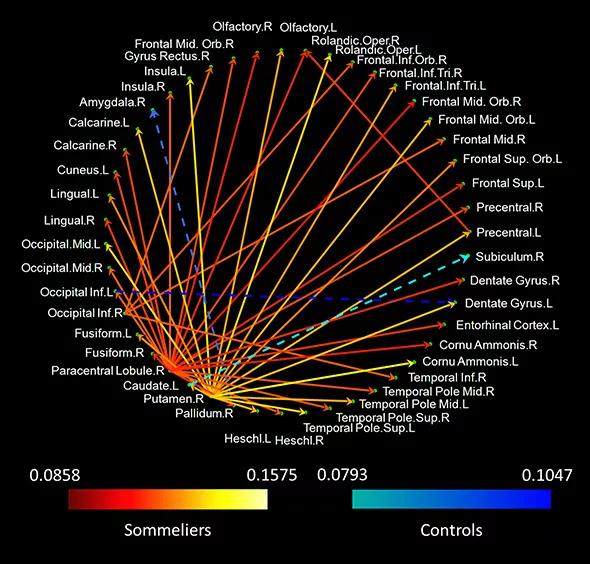
Figure 1. Circle plot depicting the connections that differed significantly between sommeliers and controls. Points on the circle represent different brain regions. Solid lines (yellow/red) are paths that were stronger in sommeliers; dotted lines (blue) are paths that were stronger in controls. The color of the edge (connection) between two regions indicates the difference in the strength of connection between the two groups.
Although the effective connectivity networks involve similar regions in the two groups, the complexity of these networks (strength of connection) was much higher in the sommeliers than in controls. Other graph-theoretic measures (global efficiency, small-worldness) are currently being investigated.

Figure 2a. Stereoscopic images (see Figure 2b legend for how best to view these images) showing the connections that were stronger in sommeliers (left) and stronger in controls (right). The large green nodes are hubs (important regions with large numbers of connections). The color of the edge (connection) between two regions indicates the difference in the strength of the connection between the two groups. Blue indicates a small difference, and red indicates a large difference. Note that no hubs were found in control subjects.
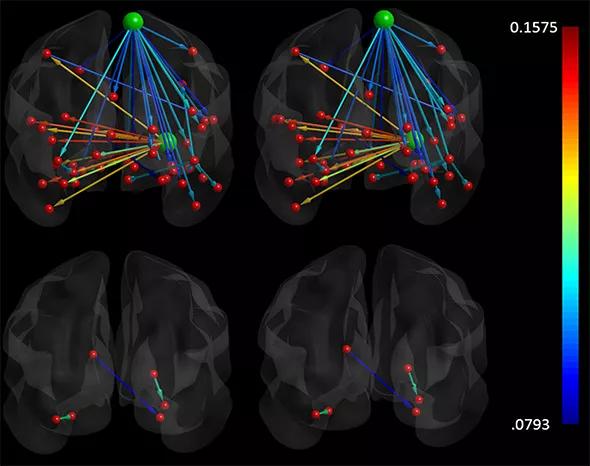
Figure 2b. More stereoscopic images showing results from our study. Explanations of colors are the same as in Figure 2a legend. The images in both these figures were generated using BrainNet Viewer.12 Stereoscopic imaging is a technique that creates or enriches the illusion of depth in an image. This is achieved by presenting a pair of nearly identical 2-D images (one for each eye) that are then combined in the brain, creating the illusion of a 3-D image. One method of viewing such images is the “out of focus” method (aka “cross-eyed view”): Focus your eyes on a point in front of the middle of the two horizontal images and try to vary the distance of this focal viewpoint to the images. At the correct focal distance, the pair of images will overlap and the brain will combine the images into a single 3-D image.
This study demonstrates the usefulness of directional connectivity models for gaining a systematic understanding of neural circuits in the brain that underlie olfaction as well as their potential as a noninvasive neuroimaging biomarker to distinguish between groups of individuals with differences in a defined characteristic. These new techniques promise to enhance understanding of neural architecture and may ultimately help improve the diagnosis of patients with cognitive disorders and the monitoring of treatment effects.
Dr. Cordes is an associate staff member in the Cleveland Clinic Lou Ruvo Center for Brain Health in Las Vegas.
Mr. Sreenivasan is an MRI image analyst in the Lou Ruvo Center for Brain Health in Las Vegas.
Ms. Zhuang is a research engineer in the Lou Ruvo Center for Brain Health in Las Vegas.
Dr. Banks is an associate staff member in the Lou Ruvo Center for Brain Health in Las Vegas.
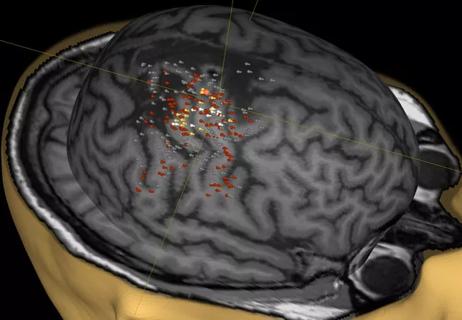
A noninvasive approach to map eloquent areas before surgery
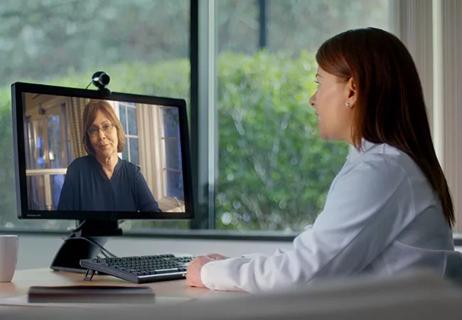
Physician reimbursement policy experts join forces with IT and coders to enable digital transformation

Minority Stroke Program focuses on outreach to racial and ethnic minority communities
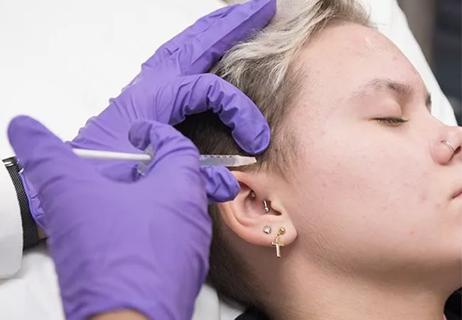
Excellent response seen with ongoing use in patients as young as 11

Q&A with a psychiatrist in Cleveland Clinic’s Transgender Surgery and Medicine Program

Time constraints, language barriers, substance misuse, mood disorders targeted for improvements

Project draws $1.6M to leverage telemedicine to create medical home, ease transition to adult care

Comorbid depression is only one of the likely warning signs